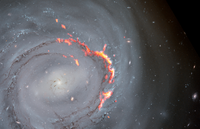Maintaining Future Star Formation
 The authors investigate the effects of ram pressure on the molecular Interstellar Medium (ISM) in the disk of the Coma cluster galaxy NGC 4921, via high resolution CO observations. They present 6 arcsec resolution CO(1-0) observations of the full disk from the Combined Array for Research in Millimeter-wave Astronomy (CARMA), and 0.4 arcsec resolution Atacama Large Millimeter/submillimeter Array CO(2-1) observations of the leading quadrant, where ram pressure is strongest. They find evidence for compression of the dense ISM on the leading side, spatially correlated with intense star formation activity in this zone. They also detect molecular gas along kiloparsec-scale filaments of dust extending into the otherwise gas stripped zone of the galaxy, seen in Hubble Space Telescope images. The authors find the filaments are connected kinematically as well as spatially to the main gas ridge located downstream, consistent with cloud decoupling inhibited by magnetic binding, and inconsistent with a simulated filament formed via simple ablation. Furthermore, we find several clouds of molecular gas ∼1-3 kpc beyond the main ring of CO that have velocities which are blueshifted by up to 50 km/s with respect to the rotation curve of the galaxy. These are some of the only clouds detected here that do not have any visible dust extinction associated with them, suggesting that they are located behind the galaxy disk midplane and are falling back towards the galaxy. Simulations have long predicted that some gas removed from the galaxy disk will fall back during ram pressure stripping. This may be the first clear observational evidence of gas re-accretion in a ram pressure stripped galaxy.
The authors investigate the effects of ram pressure on the molecular Interstellar Medium (ISM) in the disk of the Coma cluster galaxy NGC 4921, via high resolution CO observations. They present 6 arcsec resolution CO(1-0) observations of the full disk from the Combined Array for Research in Millimeter-wave Astronomy (CARMA), and 0.4 arcsec resolution Atacama Large Millimeter/submillimeter Array CO(2-1) observations of the leading quadrant, where ram pressure is strongest. They find evidence for compression of the dense ISM on the leading side, spatially correlated with intense star formation activity in this zone. They also detect molecular gas along kiloparsec-scale filaments of dust extending into the otherwise gas stripped zone of the galaxy, seen in Hubble Space Telescope images. The authors find the filaments are connected kinematically as well as spatially to the main gas ridge located downstream, consistent with cloud decoupling inhibited by magnetic binding, and inconsistent with a simulated filament formed via simple ablation. Furthermore, we find several clouds of molecular gas ∼1-3 kpc beyond the main ring of CO that have velocities which are blueshifted by up to 50 km/s with respect to the rotation curve of the galaxy. These are some of the only clouds detected here that do not have any visible dust extinction associated with them, suggesting that they are located behind the galaxy disk midplane and are falling back towards the galaxy. Simulations have long predicted that some gas removed from the galaxy disk will fall back during ram pressure stripping. This may be the first clear observational evidence of gas re-accretion in a ram pressure stripped galaxy.
Image Caption: Composite ALMA CO 2-1 and Hubble Space Telescope image of the Virgo cluster spiral galaxy, NGC 4921.
Publication: William J. Cramer (Arizona State University) et al., Molecular Gas Filaments and Fallback in the Ram Pressure Stripped Coma Spiral NGC 4921, Astrophysical Journal (accepted for ApJ [publication on 24 July 2021).
NRAO Press Release: Scientists Observe Gas Re-accretion in Dying Galaxies for the First Time




Connect with NRAO